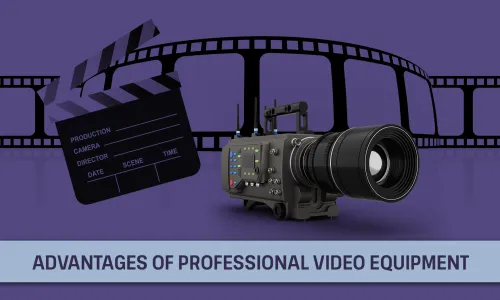TikTok, Youtube, and Instagram have contributed to video becoming in-demand content. Video content is increasingly shared online, especially when it comes to short, entertaining videos. Therefore, it has great potential for advertising and branding.
High-quality video is a must to keep viewers' attention and engagement. The video's clarity and quality influence the overall number of views and the viewer's inclination to forward the content.
One thing most people notice a lot while watching videos is the video FPS.
FPS (frames per second), or framerate tells you how many unique images are created in one second of a video. Let's dive a bit deeper to see how FPS affects video quality and how you can create high FPS videos.
What is FPS in Video Editing?
A video consists of multiple images quickly flashing on a screen one after the other to create a sense of movement. The number of those individual images used in a second is FPS. Those pictures are each referred to as "frames."
In other words, if a movie is recorded and played back at 60 frames per second, each second of the video has 60 separate still images. The motion remains fluid, and details become clearer the higher the frame rate is.
Most Popular Frame Rates
Although higher FPS will objectively give you a better video quality, paradoxically, people often prefer lower FPS videos mostly because that's what they were used to see on TV.
Also keep in mind that higher FPS means more information (more images in one second), and it is always more expensive to transfer extra information as it requires higher bandwidth... another case for using lower FPS values.
Frame rates available on modern consumer cameras can range from 1 FPS to an astounding 240 FPS. Here's a list of most commonly used frame rates and their use cases:
4-15 FPS - Used for stop-motion animations.
15-24 FPS - Used for creating GIFs.
24 FPS - The standard video frame rate for the film industry since 1920 and the frame rate people are most used to. You will set the camera to this frame rate if you record someone speaking, landscapes or if you need to get details and textures.
30 FPS - This is the standard rate for television in most parts of the world. A lot of online content has 30 FPS, so you need at least 30 FPS for streaming live videos or creating vlogs.
60 FPS - Used for sporting events, in video games, or for other high-speed actions, so the video has less motion blur. The main application of this FPS is in slow motion. Typically a video is recorded at 60 FPS, then slowed down to 24 or 30 FPS. It is widely used to slow down various shots during sporting events, add emotion to the scene, or give the subject a more graceful appearance.
120-240 FPS - The frame rate that’s also used for slow-motion, when there is a need to slow down very high speed objects like tennis balls or even flying bullets.
Why is Frame Rate Important?
The frame rate of a video significantly affects its look and feel. It affects how realistic the video appears because most people can only perceive between 30 and 60 frames per second.
Naturally, there is some motion blur present in fast motion. The frame rate you select should ideally reflect this motion blur, maintaining the most realistic experience possible.
Selecting a too low frame rate would result in a choppy video and a bad viewing experience. You should capture at a higher frame rate, ideally 60 FPS, if there is a lot of movement because it gives you greater editing freedom.
If recording at 60 FPS is not possible, read on beacuse we're gonna explain how to increase FPS using video smoothing methods.
Why We Need Video Smoothing?
These are a few situations when you may need to increase the frame rate. You may not have the best recording equipment if you have just started with video content creation. Not every camera can record images at the highest possible frame rate in the highest possible image quality.
For example, with a new GoPro HERO action camera, you can record 30 FPS in 5K quality. Most action cameras record footage in 4K quality at up to 30 FPS.
At last, people are forgetful and it may be you forgot to set your camera to 60 FPS setting.
The technique we use to increase the FPS is called video smoothing or motion interpolation.
Motion interpolation is a type of video processing in which intermediate animation frames are produced between existing ones using interpolation to make animation more fluid, compensate for display motion blur, and create faux slow-motion effects.
AI vs Non-AI Video Smoothing
Considering there are both AI and Non-AI video smoothing techniques, the results may be less than satisfactory with Non-AI algorithms. Many filmmakers have denounced non-AI smoothing as a technology that degrades movies, especially when motion smoothing settings are turned on the TV. The flaws and visual distortions it generates have made it exceedingly contentious. Hence the recommendation is to turn off this setting on the TV.
Nearest neighbor
The simplest non-AI method, known as round interpolation, simply repeats the previous frame to create an intermediate frame. Simple, but not very effective as it creates stuttering effects in fast-moving scenes.
Frame blending
It uses a technique known as cross-fading to combine two successive frames. Cross-fading is when the first frame gradually fades out, and the second frame gradually fades in. As a result, the two frames shift between each other seamlessly.
Optical flow
Uses information about the movement direction of objects between frames. This one is more advanced but slower because it requires more calculations. It tries to predict how that object will look in the next frame based on the previous movement.
AI methods
AI algorithms seamlessly generate slow-motion videos from existing content without excessive noise and unwanted artifacts. It usually implements a neural network that takes information from both frames more carefully and predicts new frames faster and more precisely.
How to Get Super Smooth Video Easily With TensorPix?
TensorPix, an AI video enhancer, offers an AI filter to increase video framerate by 2X. FPS booster filter creates smooth videos from existing old ones.
This TensorPix filter is best used for videos with 20 FPS or lower framerate. Converting videos to 60 FPS helps achieve a smooth video look from old films or low-quality animations. You won't be able to unsee the differences in motion after applying AI interpolation. With the help of the TensorPix tool, you can make your old films and documentaries upscaled to 60 FPS and even colorized.
Conclusion
As indicated by the increasing number of fan-remastered movies and TV episodes, artificial intelligence offers a promising alternative for video smoothing. The foundation of these efforts are tools like TensorPix developed to upscale and, when required, restore the individual frames of recordings, which are then reassembled into a higher-resolution rerelease.
Now that you know what FPS is and what processing technique to apply, you can start exploring available options with TensorPix.


